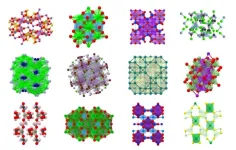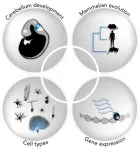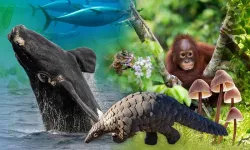(Press-News.org) It’s one of those days. On the drive home from work, the car in the next lane cuts you off. You slam on the brakes, lay on the horn, and yell choice words at the offending driver. When you walk into your house half an hour later, you’re still angry, and snap at your partner when they ask about your day.
Fruit flies may not have to worry about the lingering effects of road rage, but they also experience states of persistent aggression. In the case of female fruit flies, this behavior is a survival mechanism, causing the flies to headbutt, shove, and fence other female fruit flies to guard prime egg-laying territory on a ripe banana.
Now, researchers at Janelia and the California Institute of Technology are homing in on the neurons, circuits, and mechanisms responsible for this tenacious behavior.
In a new study, the researchers report they’ve teased out the cell types contributing to a persistent aggressive state in female fruit flies, showing that some cells associated with aggression can cause flies to remain angry for up to 10 minutes.
They also found that this persistent state may not be solely due to a recurrent connection between the aggression-associated cells, as had been thought. In a recurrent connection, signals loop back and feed into the same neural circuit, which could cause a behavior to persist.
Instead, the new research suggests persistent aggression could be regulated by other factors, including neuromodulators affecting neuronal activity, neurons downstream from the aggression-associated cells, or other circuits in the fly brain. Considering their findings, scientists may need to develop a new model that considers these other factors in addition to recurrent connections to explain this enduring behavior.
“It is interesting for the field because we talk about these recurrent connections as being key for the persistent state, and that’s really what we thought,” says Katie Schretter, a postdoc in the Rubin Lab who led the research. “But now it seems less clear in this case.”
Understanding persistent internal states like aggression could help researchers better uncover how the brain makes decisions – for instance, whether to stay mad or move on – and the individual circuits involved in these choices. Figuring out the underlying mechanisms behind aggression could also help scientists better understand aggressive behavior in humans, including behaviors that can occur alongside neurodegenerative or psychiatric diseases.
“For our society, it’s important to be able to decrease aggression and figure out how to stop persistent aggression,” Schretter says. “Figuring out how the circuit works can help us figure out how we might decrease it.”
Fighting fruit flies
Scientists had previously identified cell types associated with aggression in the brains of female fruit flies. They found that activating these cells caused the flies to fight. Given this, the team, led by Schretter, Cal Tech graduate student Hui (Vivian) Chiu, Janelia Senior Group Leader Gerry Rubin, and HHMI Investigator David Anderson, wanted to look at these cells to see how their signals might feed back into each other to generate a persistent aggressive state.
The researchers separated female flies with a barrier and then activated the different cell types associated with aggression for 30 seconds at a time. They kept the flies separated for specific periods of time, up to 30 minutes, before removing the barrier and letting them interact.
The team hypothesized that recurrent connections between certain aggression-associated cell types could cause the flies to remain aggressive for longer periods of time.
They found that one cell type associated with aggression – aIPg – contributes to persistent aggression. When these cells were activated, the flies would fight for up to 10 minutes after the barrier was removed. But another cell type previously found to be involved in aggression – pC1d – did not cause this same enduring anger.
pC1d also didn’t affect whether aIPg caused persistent aggression, and neither pC1d nor aIPg showed persistent neuronal activity. These findings suggest that a persistent aggressive state doesn’t depend on a recurrent connection between the two cell types.
Previous research had shown that stimulating another cell associated with aggression – pC1e – also does not cause persistent behavior on its own. However, Schretter and colleagues were surprised to find that when pC1d and pC1e were stimulated simultaneously, the flies remained persistently aggressive.
Taken together, the results suggest that the persistent aggressive state may be maintained by a mechanism different from what the researchers had originally thought. Instead of being due to a recurrent connection between aIPg and pC1d, as they had hypothesized, persistent aggression could involve pC1e. But it could also include other factors, such as a neuromodulator acting on the circuit or the effect of neurons downstream from aIPg, pC1d, and pC1e. Or aggression could be controlled by another circuit altogether.
Schretter says investigating these other models to explain persistent aggression is the next step.
“It’s exciting to see what else could lengthen that persistence, because there could be other circuits that are also involved,” she says. “It is basically open for us to go after, so it is a fun place to be.”
It’s one of those days. On the drive home from work, the car in the next lane cuts you off. You slam on the brakes, lay on the horn, and yell choice words at the offending driver. When you walk into your house half an hour later, you’re still angry, and snap at your partner when they ask about your day.
Fruit flies may not have to worry about the lingering effects of road rage, but they also experience states of persistent aggression. In the case of female fruit flies, this behavior is a survival mechanism, causing the flies to headbutt, shove, and fence other female fruit flies to guard prime egg-laying territory on a ripe banana.
Now, researchers at Janelia and the California Institute of Technology are homing in on the neurons, circuits, and mechanisms responsible for this tenacious behavior.
In a new study, the researchers report they’ve teased out the cell types contributing to a persistent aggressive state in female fruit flies, showing that some cells associated with aggression can cause flies to remain angry for up to 10 minutes.
They also found that this persistent state may not be solely due to a recurrent connection between the aggression-associated cells, as had been thought. In a recurrent connection, signals loop back and feed into the same neural circuit, which could cause a behavior to persist.
Instead, the new research suggests persistent aggression could be regulated by other factors, including neuromodulators affecting neuronal activity, neurons downstream from the aggression-associated cells, or other circuits in the fly brain. Considering their findings, scientists may need to develop a new model that considers these other factors in addition to recurrent connections to explain this enduring behavior.
“It is interesting for the field because we talk about these recurrent connections as being key for the persistent state, and that’s really what we thought,” says Katie Schretter, a postdoc in the Rubin Lab who led the research. “But now it seems less clear in this case.”
Understanding persistent internal states like aggression could help researchers better uncover how the brain makes decisions – for instance, whether to stay mad or move on – and the individual circuits involved in these choices. Figuring out the underlying mechanisms behind aggression could also help scientists better understand aggressive behavior in humans, including behaviors that can occur alongside neurodegenerative or psychiatric diseases.
“For our society, it’s important to be able to decrease aggression and figure out how to stop persistent aggression,” Schretter says. “Figuring out how the circuit works can help us figure out how we might decrease it.”
Fighting fruit flies
Scientists had previously identified cell types associated with aggression in the brains of female fruit flies. They found that activating these cells caused the flies to fight. Given this, the team, led by Schretter, Cal Tech graduate student Hui (Vivian) Chiu, Janelia Senior Group Leader Gerry Rubin, and HHMI Investigator David Anderson, wanted to look at these cells to see how their signals might feed back into each other to generate a persistent aggressive state.
The researchers separated female flies with a barrier and then activated the different cell types associated with aggression for 30 seconds at a time. They kept the flies separated for specific periods of time, up to 30 minutes, before removing the barrier and letting them interact.
The team hypothesized that recurrent connections between certain aggression-associated cell types could cause the flies to remain aggressive for longer periods of time.
They found that one cell type associated with aggression – aIPg – contributes to persistent aggression. When these cells were activated, the flies would fight for up to 10 minutes after the barrier was removed. But another cell type previously found to be involved in aggression – pC1d – did not cause this same enduring anger.
pC1d also didn’t affect whether aIPg caused persistent aggression, and neither pC1d nor aIPg showed persistent neuronal activity. These findings suggest that a persistent aggressive state doesn’t depend on a recurrent connection between the two cell types.
Previous research had shown that stimulating another cell associated with aggression – pC1e – also does not cause persistent behavior on its own. However, Schretter and colleagues were surprised to find that when pC1d and pC1e were stimulated simultaneously, the flies remained persistently aggressive.
Taken together, the results suggest that the persistent aggressive state may be maintained by a mechanism different from what the researchers had originally thought. Instead of being due to a recurrent connection between aIPg and pC1d, as they had hypothesized, persistent aggression could involve pC1e. But it could also include other factors, such as a neuromodulator acting on the circuit or the effect of neurons downstream from aIPg, pC1d, and pC1e. Or aggression could be controlled by another circuit altogether.
Schretter says investigating these other models to explain persistent aggression is the next step.
“It’s exciting to see what else could lengthen that persistence, because there could be other circuits that are also involved,” she says. “It is basically open for us to go after, so it is a fun place to be.”
END
Fighting fruit flies help researchers understand why we stay angry
2023-11-29
ELSE PRESS RELEASES FROM THIS DATE:
Surgeon supply by county-level rurality and social vulnerability
2023-11-29
About The Study: Between 2010 and 2020, surgeon supply per 100,000 population decreased in rural counties and increased in urban counties, and decreased in socially vulnerable counties and remained unchanged in other counties. Thus, over the past decade, disparities in surgeon supply between rural and urban counties and between socially vulnerable and other counties have widened in the U.S. The largest widening was observed among general surgeons.
Authors: Vishal R. Patel, B.S., of the Dell Medical School in Austin, Texas, is the corresponding author.
To access the embargoed study: Visit our For The Media website at this link https://media.jamanetwork.com/
(doi:10.1001/jamasurg.2023.5632)
Editor’s ...
Surgeon sex and health care costs for patients undergoing common surgical procedures
2023-11-29
About The Study: This analysis that included 1.1 million patients found lower 30-day, 90-day, and 1-year health care costs for patients treated by female surgeons compared with those treated by male surgeons. These data further underscore the importance of creating inclusive policies and environments supportive of women surgeons to improve recruitment and retention of a more diverse and representative workforce.
Authors: Christopher J. D. Wallis, M.D., Ph.D., of the University of Toronto, is the corresponding author.
To access the embargoed study: Visit our For The Media website at this link https://media.jamanetwork.com/
(doi:10.1001/jamasurg.2023.6031)
Editor’s ...
Google DeepMind adds nearly 400,000 new compounds to Berkeley Lab’s Materials Project
2023-11-29
New technology often calls for new materials – and with supercomputers and simulations, researchers don’t have to wade through inefficient guesswork to invent them from scratch.
The Materials Project, an open-access database founded at the Department of Energy’s Lawrence Berkeley National Laboratory (Berkeley Lab) in 2011, computes the properties of both known and predicted materials. Researchers can focus on promising materials for future technologies – think lighter alloys that improve fuel economy in cars, more ...
Tracing the evolution of the “little brain”
2023-11-29
The evolution of higher cognitive functions in human beings has so far mostly been linked to the expansion of the neocortex – a region of the brain that is responsible, inter alia, for conscious thought, movement and sensory perception. Researchers are increasingly realising, however, that the “little brain” or cerebellum also expanded during evolution and probably contributes to the capacities unique to humans, explains Prof. Dr Henrik Kaessmann from the Center for Molecular Biology of Heidelberg University. ...
Bees are still being harmed despite tightened pesticide regulations
2023-11-29
A new study has confirmed that pesticides, commonly used in farmland, significantly harm bumblebees – one of the most important wild pollinators. In a huge study spanning 106 sites across eight European countries, researchers have shown that despite tightened pesticide regulations, far more needs to be done.
While the agricultural uses of insecticides have been in the spotlight for their negative effects on bees, it has remained unknown how the effects scale beyond single substances in focal ...
The Global Biodiversity Data Portal: enabling biodiversity research worldwide
2023-11-29
EMBL’s European Bioinformatics Institute (EMBL-EBI) has launched the Global Biodiversity Portal – an open access data portal that will consolidate genomic information from different biodiversity projects within the Earth BioGenome Project.
Sequencing and storing the genomic data of all species on Earth is vital for future conservation and biodiversity efforts. In an era where biodiversity is under threat from various environmental pressures, there is an urgent need for centralised, accessible, and actionable data. ...
Doctors call for expanded reporting of medical care given in ICE detention centers
2023-11-29
Embargoed until November 29 11 a.m. ET
A new study led by Dr. Annette Dekker, an assistant professor in the Department of Emergency Medicine at UCLA, calls for the U.S. Immigration and Customs Enforcement (ICE) detention centers to increase health outcome reporting for detained immigrants to monitor the quality of medical care. Pulling from three different data sources, the researchers found discrepancies in care reported by emergency medical services (EMS) compared to ICE reports.
Building upon work that reviews deaths that occur at ICE detention centers, Dekker and colleagues sought to address concerns that individuals detained by ICE ...
Revisiting gene dosage
2023-11-29
Have you ever wondered why we carry two copies of each chromosome in all of our cells? During reproduction, we receive one from each of our parents. This means that we also receive two copies, or alleles, of each gene – one allele per chromosome or parent.
Both alleles are able to produce messenger RNA, which is the recipe needed to make proteins and keep cells running. Scientists hypothesize that having two alleles for each gene is the cell’s in-built redundancy system. If there is ever a mutation or drop in messenger RNA production from the allele carried on one of the chromosomes, the allele on the second chromosome will serve as a backup and ...
Scientists discover rare 6-planet system that moves in strange synchrony
2023-11-29
Scientists have discovered a rare sight in a nearby star system: Six planets orbiting their central star in a rhythmic beat. The planets move in an orbital waltz that repeats itself so precisely it can be readily set to music.
A rare case of an “in sync” gravitational lockstep, the system could offer deep insight into planet formation and evolution.
The analysis, led by UChicago scientist Rafael Luque, will be published Nov. 29 in Nature.
“This discovery is going to become a benchmark system to study how sub-Neptunes, the most common type of planets outside of the solar system, form, evolve, what are they made of, and if they possess the ...
Disruptive ideas rely on old fashioned meetings
2023-11-29
A marvel of modernity is the ability to collaborate with others regardless of location. Researchers can work with a colleague, maybe the only person who has a specialized skill, even if they are halfway across the globe. They can pull together a powerhouse team with a dozen of the brightest minds in the field.
Yet, according to research from the lab of Lingfei Wu, assistant professor in Pitt’s School of Computing and Information, these collaborative teams are producing fewer truly disruptive ideas or radical innovations than ...




